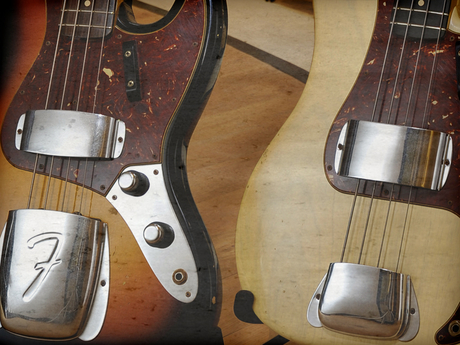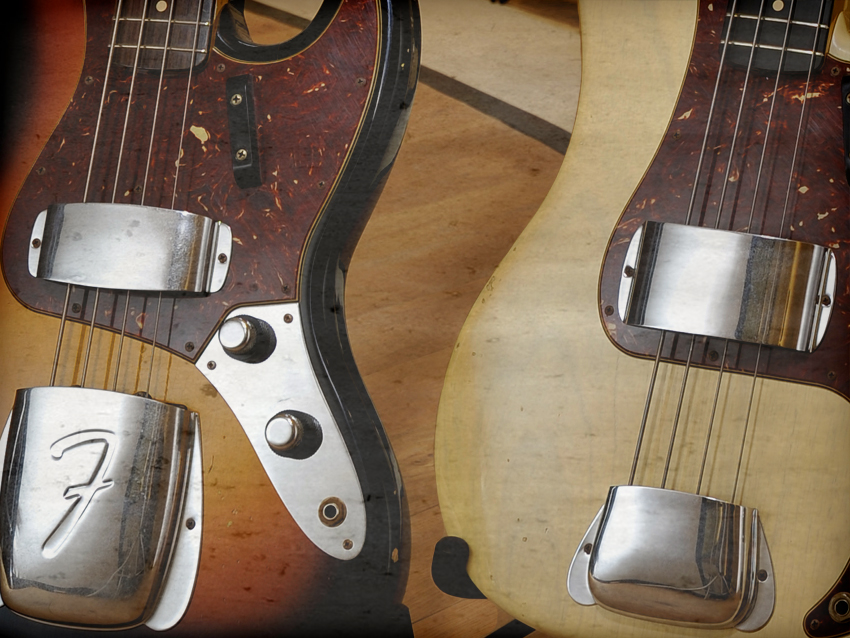The story of Fender's Precision and Jazz basses


When Leo Fender first drew up the plans for the Precision Bass, he would have been astounded to think that his designs would become the accepted standard of bass guitar and that it would still be in production over 60 years later.
Naturally there have been some changes along the way, the most significant in 1957 when the slab body features inherited from the Telecaster were transformed into the sleek, curvaceous form that we know and love today. This was also the time when the split-coil pickup was introduced and the bass found its distinctive sound and feel.
In comparison, every other change over the years has felt like minor tweaking. Of course, the active electronics of the '80s models helped to improve the tonal spectrum, but these days the trend is to acknowledge the undeniable benefits of those early passive circuits.
Ideally named, the Precision did indeed offer bass players the chance to produce perfectly pitched notes. It also offered amazing portability over the prevalent acoustic uprights of the day, and bass playing became much more popular as a result.
Monk Montgomery is acknowledged as the first bass guitar champion, playing an original Precision with Lionel Hampton's band back in 1951 - the year the bass was introduced. For more on the early days of the electric bass click here.
Transatlantic impact
In Britain we had European bass guitars but were largely unaware of this revolutionary instrument until The Shadows came along and Fender guitars became a household name. Jet Harris brought electric bass playing into focus, and although new and distinctive basses were constantly appearing during the '60s, none seemed to have as much general appeal until the Jazz Bass appeared.
When the Jazz Bass debuted in 1960 it was initially advertised as the 'two pickup Precision', but this it most certainly wasn't. The Precision gets its distinctive sound from the over-wound split-coil pickup (more like a humbucker) while the Jazz was equipped with a pair of single-coil units.
Get the MusicRadar Newsletter
Want all the hottest music and gear news, reviews, deals, features and more, direct to your inbox? Sign up here.
The body combined elements of Fender's Stratocaster and Jazzmaster guitars to provide a twin cutaway design set at an offset angle with a startlingly narrow neck and fretboard. This created a visual sleekness about the Jazz design that also added comfort and ease of play.
Initially the pickups were adjusted by a pair of dual concentric (stacked) knobs, but these could be unreliable so were soon replaced by the two volumes and one tone control that we are familiar with today. Little else has changed.
So why the continued popularity of both models? Quite simply, they both do a fine job but are different enough in sonic ability to collectively appeal to nearly all bassists. And while overall weights may vary (depending on the body wood), good balance is always guaranteed along with the consistent sound qualities.
The Precision has provided the solid bass foundation heard on thousands of pop and rock records, while the Jazz has proved to be remarkably adaptable to the changes in musical trends in bass playing and most session players own one.
This is due largely to the incredible flexibility of sound that can be achieved from having two identical pickups with individual volumes: by varying the quantity of signal produced by each pickup a myriad subtle tonal changes become available and, as if by magic, the so-called 'sweet spot' appears. This is where the bass actually seems to sing.
Famous Jazzers
It was a sound that Jaco Pastorius exploited to the full with jazz-fusion pioneers Weather Report, but this blending ability also allows for extra note definition, even when you're using a predominantly bassy sound.
John Entwistle found the Jazz's extra treble ideal for defining The Who's unique sound; Jimi Hendrix Experience bassist Noel Redding also took advantage of the bass's clarity when he needed to hold the band together during drummer Mitch Mitchell's wilder moments.
And, as a former guitarist, Redding also preferred the slimmer dimensions of the Jazz neck. John Paul Jones and Norman Watt-Roy also favoured the Jazz for Led Zeppelin and The Blockheads respectively, for its deep tone and clear note definition.
Because of the markedly different characteristics it comes as no surprise that most players tend to champion one bass or the other. For this writer, the slightly chunkier dimensions of the Precision fretboard and the powerful split-coil pickup offer an unrivalled solid sound and feel. However, the slimmer neck and versatile twin single-coils draw many players towards the Jazz.
Both basses were designed to have two cover plates to secrete the bridge and central pickup, but for fingerstyle players these tended to get in the way and were often removed.
In response Fender dropped them on its production line models and only offers covers with its vintage reissue models. Purists like them to be there, modernists prefer them removed, but when fitted they do make a remarkable difference to the playing experience and the access to the strings is greatly inhibited - particularly on the Jazz.
Understandably, Fender couldn't resist a degree of cross-pollination over the years. The Precision was embellished with an added Jazz pickup or a pair of split-coils, and many were offered with thinner necks. The Jazz, however, has tended to stay truer to its origins, although it has found favour in a five-string configuration. But whatever may come in the future, it's undeniable that no two basses will ever have such an illustrious past.
“I really thought I was going to die... and it absolutely was so freeing”: Blink 182’s Mark Hoppus talks surviving cancer and his band’s resurrection
"I remember showing up at 10 or 11 in the morning and working on solos and that leading to two or three o’clock in the morning the next day”: How Metallica beat the clock and battled fatigue to create a poignant and pulverising anti-war epic









